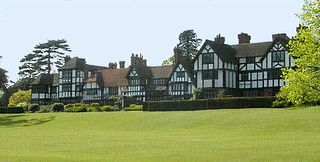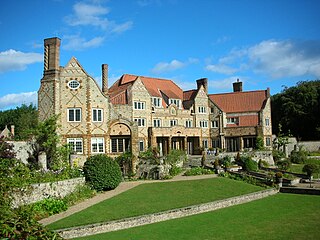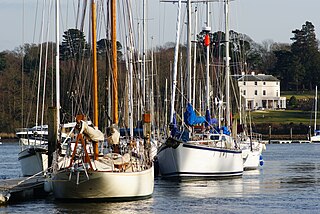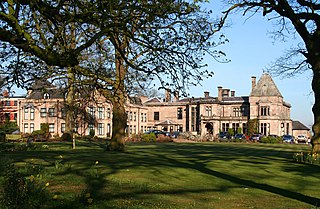
Gertrude Jekyll was a British horticulturist, garden designer, craftswoman, photographer, writer and artist. She created over 400 gardens in the United Kingdom, Europe and the United States, and wrote over 1000 articles for magazines such as Country Life and William Robinson's The Garden. Jekyll has been described as "a premier influence in garden design" by British and American gardening enthusiasts.
Country Life is a British weekly perfect-bound glossy magazine that is published by Future plc. It was based in London at 110 Southwark Street until March 2016, when moved to Farnborough, Hampshire. In 2022, the magazine moved back to London at 121 – 141 Westbourne Terrace, Paddington.

Lindisfarne Castle is a 16th-century castle located on Holy Island, near Berwick-upon-Tweed, Northumberland, England, much altered by Sir Edwin Lutyens in 1901. The island is accessible from the mainland at low tide by means of a causeway.

Tudor Revival architecture, also known as mock Tudor in the UK, first manifested in domestic architecture in the United Kingdom in the latter half of the 19th century. Based on revival of aspects that were perceived as Tudor architecture, in reality it usually took the style of English vernacular architecture of the Middle Ages that had survived into the Tudor period. The style later became an influence elsewhere, especially the British colonies. For example, in New Zealand, the architect Francis Petre adapted the style for the local climate. In Singapore, then a British colony, architects such as Regent Alfred John Bidwell pioneered what became known as the Black and White House. The earliest examples of the style originate with the works of such eminent architects as Norman Shaw and George Devey, in what at the time was considered Neo-Tudor design.

Capesthorne Hall is a country house near the village of Siddington, Cheshire, England. The house and its private chapel were built in the early 18th century, replacing an earlier hall and chapel nearby. They were built to Neoclassical designs by William Smith and (probably) his son Francis. Later in the 18th century, the house was extended by the addition of an orangery and a drawing room. In the 1830s the house was remodelled by Edward Blore; the work included the addition of an extension and a frontage in Jacobean style, and joining the central block to the service wings. In about 1837 the orangery was replaced by a large conservatory designed by Joseph Paxton. In 1861 the main part of the house was virtually destroyed by fire. It was rebuilt by Anthony Salvin, who generally followed Blore's designs but made modifications to the front, rebuilt the back of the house in Jacobean style, and altered the interior. There were further alterations later in the 19th century, including remodelling of the Saloon. During the Second World War the hall was used by the Red Cross, but subsequent deterioration prompted a restoration.

Home Place, also called Voewood, is an Arts and Crafts style house in High Kelling, near Holt, Norfolk, England, designed (1903–5) by Edward Schroeder Prior. It is a Grade II* listed building. The gardens, also designed by Prior, are Grade II* listed in the National Register of Historic Parks and Gardens.

Peover Hall is a country house in the civil parish of Peover Superior, commonly known as Over Peover, Cheshire, England. It is recorded in the National Heritage List for England as a designated Grade II* listed building.

Sir Lawrence Walter William Weaver (1876–1930) was an English architectural writer and civil servant.

Port Lympne, at Lympne, Kent is an early 20th-century country house built for Sir Philip Sassoon by Herbert Baker and Philip Tilden. Completed after the First World War. Following Sassoon's death in 1939 it was bequeathed with its contents, including cars and planes, to Hannah Gubbay, his cousin. It was abandoned after the Second World War. In 1973, it was purchased by John Aspinall as part of an expansion of his Port Lympne Zoo. The house is a Grade II* listed building as of 29 December 1966.

Orchards is an Arts and Crafts style house in Bramley in Surrey, England. It is on Bramley's boundary with Busbridge and 1 mile (1.6 km) south-east of Godalming town centre. Described by English Heritage as the first major work of architect Edwin Lutyens, it is a Grade I listed building. The gardens are Grade II* listed in the National Register of Historic Parks and Gardens. The property is privately owned.
Berden Hall is a Grade II* listed Elizabethan country house in Berden, in the Uttlesford District of Essex, England. The house was built in the 1580s. In 2012 the house was on the market for £3.5 million.

Heathcote is a Neoclassical-style villa in Ilkley, West Yorkshire, England. Designed by architect Edwin Lutyens, it was his first comprehensive use of that style, making it the precursor of his later public buildings in Edwardian Baroque style and those of New Delhi. It was completed in 1908.

The Salutation is a grade I listed house in Sandwich, Kent, England. It was designed and built by Edwin Lutyens in a Queen Anne style in 1911–12, as a weekend home and country retreat for members of the Farrer family. It was one of the first 20th-century building to be given a grade I listing, in 1950. Other structures in the grounds received a grade II listing in 1986. It has been described by Nigel Jones as "the perfect house that many in Britain aspire to own", and by Arthur Stanley George Butler as "Sir Edwin's supreme rendering of the full Georgian idiom … This very perfect work establishes itself as a high peak in Sir Edwin's achievement".

Marshcourt, also spelled Marsh Court, is an Arts and Crafts style country house in Marsh Court, near Stockbridge, Hampshire, England. It is constructed from quarried chalk. Designed and built by architect Edwin Lutyens between 1901 and 1905, it is a Grade I listed building. The gardens, designed by Lutyens and Gertrude Jekyll, are Grade II* listed in the National Register of Historic Parks and Gardens.

Folly Farm is an Arts and Crafts style country house in Sulhamstead, West Berkshire, England. Built around a small farmhouse dating to c. 1650, the house was substantially extended in William and Mary style by architect Edwin Lutyens c. 1906, and further extended by him in vernacular style c. 1912. It is a Grade I listed building. The gardens, designed by Lutyens and Gertrude Jekyll, are Grade II* listed in the National Register of Historic Parks and Gardens. They are among the best-known gardens of the Lutyens/Jekyll partnership.

Goddards House and Garden is an Arts and Crafts house in Dringhouses, York, England. It was built in 1927 for Noel and Kathleen Terry of the famed chocolate-manufacturing family Terry's with the house designed by local architect Walter Brierley and the garden by George Dillistone. The National Trust acquired the property in 1984 to use as regional offices and the garden and parts of the house are open to visitors with displays telling the story of the family and their confectionery business. The house is a Grade I listed building and the carriage entrance to the property is Grade II* listed.

Brooklands is an 18th-century country house in Sarisbury in Fareham in the English county of Hampshire. The grounds of the house overlook the River Hamble. It has been listed Grade II* on the National Heritage List for England since October 1976.

Bishopthorpe Garth is a grade II listed house on the edge of Bishopthorpe, a village south of York, in England.


















